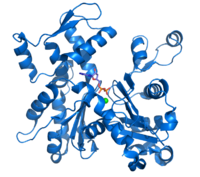
Photo from wikipedia
Purpose Ascofuranone is an antiviral antibiotic that is known to exert multiple anti-tumor effects, including cell cycle arrest, inhibition of mitochondrial respiration, and inhibition of angiogenesis. In this study, we… Click to show full abstract
Purpose Ascofuranone is an antiviral antibiotic that is known to exert multiple anti-tumor effects, including cell cycle arrest, inhibition of mitochondrial respiration, and inhibition of angiogenesis. In this study, we investigated the molecular mechanisms underlying the anti-metastatic effects of ascofuranone in insulin-like growth factor-I (IGF-1)-responsive cancer cells. Methods The inhibitory effect of ascofuranone on cancer cell migration and invasion was assessed using scratch wound healing and Matrigel invasion assays, respectively. F-actin cytoskeleton organization was assessed using FITC conjugated phalloidin staining. Target gene expression was evaluated using Western blotting and gene silencing was performed using siRNA transfections. Finally, the anti-metastatic effect of ascofuranone was investigated in vivo . Results We found that ascofuranone suppressed IGF-1-induced cell migration, invasion and motility in multiple cancer cell lines. The effects of ascofuranone on actin cytoskeleton organization were found to be mediated by suppression of the mTOR/p70S6K/4EBP1 pathway. Ascofuranone inhibited IGF-1-induced mTOR phosphorylation and actin cytoskeleton organization via upregulation of AMPK and downregulation of Akt phosphorylation. It also selectively suppressed the IGF-1-induced mTOR complex (mTORC)1 by phosphorylation of Raptor, but did not affect mTORC2. Furthermore, we found that focal adhesion kinase (FAK) activation decreased in response to ascofuranone, rapamycin, compound C and wortmannin treatment. Finally, we found that ascofuranone suppressed phosphorylation of FAK and mTOR and dephosphorylation of Raptor in cancerous metastatic lung tissues in vivo . Conclusions Our data indicate that ascofuranone suppresses IGF-1-induced cancer cell migration and invasion by blocking actin cytoskeleton organization and FAK activation through inhibition of the mTORC1 pathway, and reveal a novel anti-metastatic function of this compound.
Journal Title: Cellular Oncology
Year Published: 2020
Link to full text (if available)
Share on Social Media: Sign Up to like & get
recommendations!